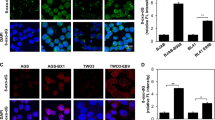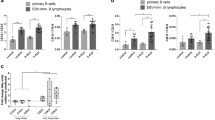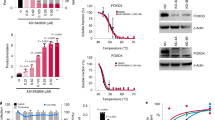Abstract
Infection of human B lymphocytes by Epstein–Barr virus (EBV) leads to the establishment of immortalized lymphoblastoid cell lines (LCLs) that are widely used as a model of viral oncogenesis. An early consequence of infection is the induction of DNA damage and activation of the DNA damage response, which limits the efficiency of growth transformation. The cause of the DNA damage remains poorly understood. We have addressed this question by comparing the response of B lymphocytes infected with EBV or stimulated with a potent B-cell mitogen. We found that although the two stimuli induce comparable proliferation during the first 10 days of culture, the EBV-infected blasts showed significantly higher levels of DNA damage, which correlated with stronger and sustained accumulation of reactive oxygen species (ROS). Treatment with ROS scavengers decreased DNA damage in both mitogen-stimulated and EBV-infected cells. However, while mitogen-induced proliferation was slightly improved, the proliferation of EBV-infected cells and the establishment of LCLs were severely impaired. Quenching of ROS did not affect the kinetics and magnitude of viral gene expression but was associated with selective downregulation of the viral LMP1 and phosphorylated cellular transcription factor STAT3 that have key roles in transformation. Analysis of the mechanism by which high levels of ROS support LMP1 expression revealed selective inhibition of viral microRNAs that target the LMP1 transcript. Our study provides novel insights into the role of EBV-induced oxidative stress in promoting B-cell immortalization and malignant transformation.
This is a preview of subscription content, access via your institution
Access options
Subscribe to this journal
Receive 50 print issues and online access
$259.00 per year
only $5.18 per issue
Buy this article
- Purchase on Springer Link
- Instant access to full article PDF
Prices may be subject to local taxes which are calculated during checkout







Similar content being viewed by others
References
Rickinson A . Epstein-Barr virus. Virus Res 2002; 82: 109–113.
Diehl V, Henle G, Henle W, Kohn G . Demonstration of a herpes group virus in cultures of peripheral leukocytes from patients with infectious mononucleosis. J Virol 1968; 2: 663–669.
Nalesnik MA, Jaffe R, Starzl TE, Demetris AJ, Porter K, Burnham JA et al. The pathology of posttransplant lymphoproliferative disorders occurring in the setting of cyclosporine A-prednisone immunosuppression. Am J Pathol 1988; 133: 173–192.
Dolcetti R, Masucci MG . Epstein-Barr virus: induction and control of cell transformation. J Cell Physiol 2003; 196: 207–218.
Leibold W, Flanagan TD, Menezes J, Klein G . Induction of Epstein-Barr virus-associated nuclear antigen during in vitro transformation of human lymphoid cells. J Natl Cancer Inst 1975; 54: 65–68.
Rickinson AB, Kieff E . Epstein-Barr virus In: Fields BN, Knipe DM, Howley PM eds. Virology. Lippincott-Raven: Philadelphia, 1996, pp 2397–2446.
Grossman SR, Johannsen E, Tong X, Yalamanchili R, Kieff E . The Epstein-Barr virus nuclear antigen 2 transactivator is directed to response elements by the J kappa recombination signal binding protein. Proc Natl Acad Sci USA 1994; 91: 7568–7572.
Henkel T, Ling PD, Hayward SD, Peterson MG . Mediation of Epstein-Barr virus EBNA2 transactivation by recombination signal-binding protein J kappa. Science 1994; 265: 92–95.
Zhao B, Zou J, Wang H, Johannsen E, Peng CW, Quackenbush J et al. Epstein-Barr virus exploits intrinsic B-lymphocyte transcription programs to achieve immortal cell growth. Proc Natl Acad Sci USA 2011; 108: 14902–14907.
Kaiser C, Laux G, Eick D, Jochner N, Bornkamm GW, Kempkes B . The proto-oncogene c-myc is a direct target gene of Epstein-Barr virus nuclear antigen 2. J Virol 1999; 73: 4481–4484.
Portal D, Zhou H, Zhao B, Kharchenko PV, Lowry E, Wong L et al. Epstein-Barr virus nuclear antigen leader protein localizes to promoters and enhancers with cell transcription factors and EBNA2. Proc Natl Acad Sci USA 2013; 110: 18537–18542.
White RE, Groves IJ, Turro E, Yee J, Kremmer E, Allday MJ . Extensive co-operation between the Epstein-Barr virus EBNA3 proteins in the manipulation of host gene expression and epigenetic chromatin modification. PLoS One 2010; 5: e13979.
Touitou R, Hickabottom M, Parker G, Crook T, Allday MJ . Physical and functional interactions between the corepressor CtBP and the Epstein-Barr virus nuclear antigen EBNA3C. J Virol 2001; 75: 7749–7755.
Knight JS, Lan K, Subramanian C, Robertson ES . Epstein-Barr virus nuclear antigen 3C recruits histone deacetylase activity and associates with the corepressors mSin3A and NCoR in human B-cell lines. J Virol 2003; 77: 4261–4272.
Yates J, Warren N, Reisman D, Sugden B . A cis-acting element from the Epstein-Barr viral genome that permits stable replication of recombinant plasmids in latently infected cells. Proc Natl Acad Sci USA 1984; 81: 3806–3810.
Altmann M, Pich D, Ruiss R, Wang J, Sugden B, Hammerschmidt W . Transcriptional activation by EBV nuclear antigen 1 is essential for the expression of EBV's transforming genes. Proc Natl Acad Sci USA 2006; 103: 14188–14193.
Reisman D, Sugden B . trans activation of an Epstein-Barr viral transcriptional enhancer by the Epstein-Barr viral nuclear antigen 1. Mol Cell Biol 1986; 6: 3838–3846.
Sompallae R, Callegari S, Kamranvar SA, Masucci MG . Transcription profiling of Epstein-Barr virus nuclear antigen (EBNA)-1 expressing cells suggests targeting of chromatin remodeling complexes. PLoS One 2010; 5: e12052.
Mosialos G, Birkenbach M, Yalamanchili R, VanArsdale T, Ware C, Kieff E . The Epstein-Barr virus transforming protein LMP1 engages signaling proteins for the tumor necrosis factor receptor family. Cell 1995; 80: 389–399.
Hu LF, Chen F, Zheng X, Ernberg I, Cao SL, Christensson B et al. Clonability and tumorigenicity of human epithelial cells expressing the EBV encoded membrane protein LMP1. Oncogene 1993; 8: 1575–1583.
Kulwichit W, Edwards RH, Davenport EM, Baskar JF, Godfrey V, Raab-Traub N . Expression of the Epstein-Barr virus latent membrane protein 1 induces B cell lymphoma in transgenic mice. Proc Natl Acad Sci USA 1998; 95: 11963–11968.
Miller CL, Burkhardt AL, Lee JH, Stealey B, Longnecker R, Bolen JB et al. Integral membrane protein 2 of Epstein-Barr virus regulates reactivation from latency through dominant negative effects on protein-tyrosine kinases. Immunity 1995; 2: 155–166.
Ingham RJ, Raaijmakers J, Lim CS, Mbamalu G, Gish G, Chen F et al. The Epstein-Barr virus protein, latent membrane protein 2A, co-opts tyrosine kinases used by the T cell receptor. J Biol Chem 2005; 280: 34133–34142.
Nikitin PA, Yan CM, Forte E, Bocedi A, Tourigny JP, White RE et al. An ATM/Chk2-mediated DNA damage-responsive signaling pathway suppresses Epstein-Barr virus transformation of primary human B cells. Cell Host Microbe 2010; 8: 510–522.
Weitzman MD, Weitzman JB . What's the damage? The impact of pathogens on pathways that maintain host genome integrity. Cell Host Microbe 2014; 15: 283–294.
Grand RJ, Ibrahim AP, Taylor AM, Milner AE, Gregory CD, Gallimore PH et al. Human cells arrest in S phase in response to adenovirus 12 E1A. Virology 1998; 244: 330–342.
Davy C, Doorbar J . G2/M cell cycle arrest in the life cycle of viruses. Virology 2007; 368: 219–226.
Koopal S, Furuhjelm JH, Jarviluoma A, Jaamaa S, Pyakurel P, Pussinen C et al. Viral oncogene-induced DNA damage response is activated in Kaposi sarcoma tumorigenesis. PLoS Pathog 2007; 3: 1348–1360.
Gruhne B, Sompallae R, Marescotti D, Kamranvar SA, Gastaldello S, Masucci MG . The Epstein-Barr virus nuclear antigen-1 promotes genomic instability via induction of reactive oxygen species. Proc Natl Acad Sci USA 2009; 106: 2313–2318.
Kinjo T, Ham-Terhune J, Peloponese JM Jr, Jeang KT . Induction of reactive oxygen species by human T-cell leukemia virus type 1 tax correlates with DNA damage and expression of cellular senescence marker. J Virol 2010; 84: 5431–5437.
Ates B, Abraham L, Ercal N . Antioxidant and free radical scavenging properties of N-acetylcysteine amide (NACA) and comparison with N-acetylcysteine (NAC). Free Radic Res 2008; 42: 372–377.
Sunitha K, Hemshekhar M, Thushara RM, Santhosh MS, Yariswamy M, Kemparaju K et al. N-Acetylcysteine amide: a derivative to fulfill the promises of N-Acetylcysteine. Free Radic Res 2013; 47: 357–367.
Bottero V, Chakraborty S, Chandran B . Reactive oxygen species are induced by Kaposi's sarcoma-associated herpesvirus early during primary infection of endothelial cells to promote virus entry. J Virol 2013; 87: 1733–1749.
Price AM, Luftig MA . Dynamic Epstein-Barr virus gene expression on the path to B-cell transformation. Adv Virus Res 2014; 88: 279–313.
Jochum S, Ruiss R, Moosmann A, Hammerschmidt W, Zeidler R . RNAs in Epstein-Barr virions control early steps of infection. Proc Natl Acad Sci USA 2012; 109: E1396–E1404.
Koganti S, Hui-Yuen J, McAllister S, Gardner B, Grasser F, Palendira U et al. STAT3 interrupts ATR-Chk1 signaling to allow oncovirus-mediated cell proliferation. Proc Natl Acad Sci USA 2014; 111: 4946–4951.
Koganti S, de la Paz A, Freeman AF, Bhaduri-McIntosh S . B lymphocytes from patients with a hypomorphic mutation in STAT3 resist Epstein-Barr virus-driven cell proliferation. J Virol 2014; 88: 516–524.
Lee YJ, Heo JS, Suh HN, Lee MY, Han HJ . Interleukin-6 stimulates alpha-MG uptake in renal proximal tubule cells: involvement of STAT3, PI3K/Akt, MAPKs, and NF-kappaB. Am J Physiol Renal Physiol 2007; 293: F1036–F1046.
Souza V, Escobar Mdel C, Bucio L, Hernandez E, Gomez-Quiroz LE, Gutierrez Ruiz MC . NADPH oxidase and ERK1/2 are involved in cadmium induced-STAT3 activation in HepG2 cells. Toxicol Lett 2009; 187: 180–186.
Schust J, Sperl B, Hollis A, Mayer TU, Berg T . Stattic: a small-molecule inhibitor of STAT3 activation and dimerization. Chem Biol 2006; 13: 1235–1242.
Bartel DP . MicroRNAs: genomics, biogenesis, mechanism, and function. Cell 2004; 116: 281–297.
Lo AK, To KF, Lo KW, Lung RW, Hui JW, Liao G et al. Modulation of LMP1 protein expression by EBV-encoded microRNAs. Proc Natl Acad Sci USA 2007; 104: 16164–16169.
Skalsky RL, Corcoran DL, Gottwein E, Frank CL, Kang D, Hafner M et al. The viral and cellular microRNA targetome in lymphoblastoid cell lines. PLoS Pathog 2012; 8: e1002484.
Skalsky RL, Kang D, Linnstaedt SD, Cullen BR . Evolutionary conservation of primate lymphocryptovirus microRNA targets. J Virol 2014; 88: 1617–1635.
Schwarz KB . Oxidative stress during viral infection: a review. Free Radic Biol Med 1996; 21: 641–649.
Nikitin PA, Price AM, McFadden K, Yan CM, Luftig MA . Mitogen-induced B-cell proliferation activates Chk2-dependent G1/S cell cycle arrest. PLoS One 2014; 9: e87299.
Halazonetis TD, Gorgoulis VG, Bartek J . An oncogene-induced DNA damage model for cancer development. Science 2008; 319: 1352–1355.
Maya-Mendoza A, Ostrakova J, Kosar M, Hall A, Duskova P, Mistrik M et al. Myc and Ras oncogenes engage different energy metabolism programs and evoke distinct patterns of oxidative and DNA replication stress. Mol Oncol 2015; 9: 601–616.
Gargouri B, Nasr R, ben Mansour R, Lassoued S, Mseddi M, Attia H et al. Reactive oxygen species production and antioxidant enzyme expression after Epstein-Barr virus lytic cycle induction in Raji cell line. Biol Trace Elem Res 2011; 144: 1449–1457.
Huen DS, Henderson SA, Croom-Carter D, Rowe M . The Epstein-Barr virus latent membrane protein-1 (LMP1) mediates activation of NF-kappa B and cell surface phenotype via two effector regions in its carboxy-terminal cytoplasmic domain. Oncogene 1995; 10: 549–560.
Roberts ML, Cooper NR . Activation of a ras-MAPK-dependent pathway by Epstein-Barr virus latent membrane protein 1 is essential for cellular transformation. Virology 1998; 240: 93–99.
Laherty CD, Hu HM, Opipari AW, Wang F, Dixit VM . The Epstein-Barr virus LMP1 gene product induces A20 zinc finger protein expression by activating nuclear factor kappa B. J Biol Chem 1992; 267: 24157–24160.
Gruhne B, Sompallae R, Masucci MG . Three Epstein-Barr virus latency proteins independently promote genomic instability by inducing DNA damage, inhibiting DNA repair and inactivating cell cycle checkpoints. Oncogene 2009; 28: 3997–4008.
Carpenter RL, Lo HW . STAT3 target genes relevant to human cancers. Cancers (Basel) 2014; 6: 897–925.
Ma Q, Cavallin LE, Leung HJ, Chiozzini C, Goldschmidt-Clermont PJ, Mesri EA . A role for virally induced reactive oxygen species in Kaposi's sarcoma herpesvirus tumorigenesis. Antioxid Redox Signal 2013; 18: 80–90.
Liu T, Castro S, Brasier AR, Jamaluddin M, Garofalo RP, Casola A . Reactive oxygen species mediate virus-induced STAT activation: role of tyrosine phosphatases. J Biol Chem 2004; 279: 2461–2469.
Gires O, Kohlhuber F, Kilger E, Baumann M, Kieser A, Kaiser C et al. Latent membrane protein 1 of Epstein-Barr virus interacts with JAK3 and activates STAT proteins. EMBO J 1999; 18: 3064–3073.
Dando I, Cordani M, Dalla Pozza E, Biondani G, Donadelli M, Palmieri M . Antioxidant mechanisms and ROS-related microRNAs in cancer stem cells. Oxid Med Cell Longev 2015; 2015: 425708.
Riley KJ, Rabinowitz GS, Yario TA, Luna JM, Darnell RB, Steitz JA . EBV and human microRNAs co-target oncogenic and apoptotic viral and human genes during latency. EMBO J 2012; 31: 2207–2221.
Le Clorennec C, Ouk TS, Youlyouz-Marfak I, Panteix S, Martin CC, Rastelli J et al. Molecular basis of cytotoxicity of Epstein-Barr virus (EBV) latent membrane protein 1 (LMP1) in EBV latency III B cells: LMP1 induces type II ligand-independent autoactivation of CD95/Fas with caspase 8-mediated apoptosis. J Virol 2008; 82: 6721–6733.
Miller G, Shope T, Lisco H, Stitt D, Lipman M . Epstein-Barr virus: transformation, cytopathic changes, and viral antigens in squirrel monkey and marmoset leukocytes. Proc Natl Acad Sci USA 1972; 69: 383–387.
Acknowledgements
This study was supported by grants awarded by the Swedish Cancer Society, the Swedish Medical Research Council and the Karolinska Institutet, Stockholm, Sweden. XC was partly supported by a fellowship awarded by the China Scholarship Council. We are grateful to Dr Glenn Goldstein (David Pharmaceuticals, NY, USA), Dr Svante Norgren (Karolinska University Hospital, Stockholm, Sweden) and Dr Jaap Middeldorp (Vrije Universiteit, Amsterdam, The Netherlands) for providing chemicals and antibodies. The contribution of the master student Iris Valent is gratefully acknowledged.
Author information
Authors and Affiliations
Corresponding author
Ethics declarations
Competing interests
The authors declare no conflict of interest.
Additional information
Supplementary Information accompanies this paper on the Oncogene website
Rights and permissions
About this article
Cite this article
Chen, X., Kamranvar, S. & Masucci, M. Oxidative stress enables Epstein–Barr virus-induced B-cell transformation by posttranscriptional regulation of viral and cellular growth-promoting factors. Oncogene 35, 3807–3816 (2016). https://doi.org/10.1038/onc.2015.450
Received:
Revised:
Accepted:
Published:
Issue Date:
DOI: https://doi.org/10.1038/onc.2015.450
This article is cited by
-
Targeting K-Ras and apoptosis-driven cellular transformation in cancer
Cell Death Discovery (2021)
-
The Epstein–Barr virus nuclear antigen-1 upregulates the cellular antioxidant defense to enable B-cell growth transformation and immortalization
Oncogene (2020)
-
Epstein-Barr Virus Latent Membrane Protein-1 Induces the Expression of SUMO-1 and SUMO-2/3 in LMP1-positive Lymphomas and Cells
Scientific Reports (2019)
-
Disruption of direct 3D telomere–TRF2 interaction through two molecularly disparate mechanisms is a hallmark of primary Hodgkin and Reed–Sternberg cells
Laboratory Investigation (2017)
-
Limited nucleotide pools restrict Epstein–Barr virus-mediated B-cell immortalization
Oncogenesis (2017)



